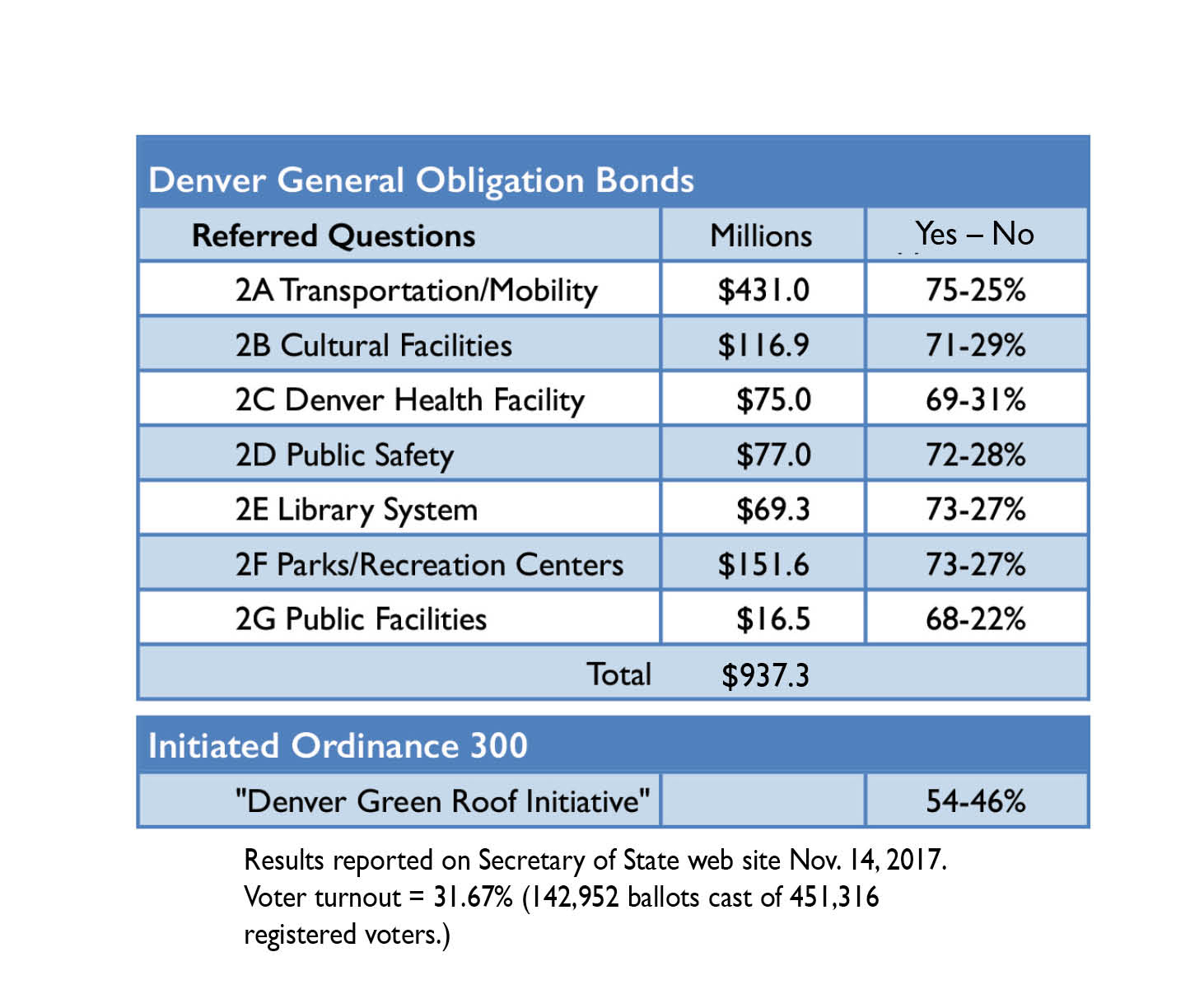
Denver voters approved all the measures presented to them in the Nov. 7 general election. They ranged from a citywide $937 million bond package to relatively small special district taxes. The biggest surprise of the election evening was approval of Initiated Ordinance 300 that will now require green roof features (gardens and/or solar panels) on new buildings or additions exceeding a threshold size. Results of the two special district elections are reported here as well because they interact with the citywide issues. Highlights of each measure are presented below.
Denver GO Bonds 2017
Denver GO Bonds 2017. None of the seven project categories received less than two-thirds support, with the transportation package proving most popular at 75 percent. Projects are roughly evenly split between repairs and improvements. Transportation accounts for 44 percent of total spending and will go toward 287 miles of road paving, 33 miles of sidewalks and 49 miles of bikeways. Other bond funds will pay for renovations at dozens of city libraries, recreation centers and police and fire stations. In addition to city projects, the bonds will support capital improvements at six cultural and art organizations as well as a new outpatient Ambulatory Care Center for the Denver Health and Hospital Authority. (Details on project categories are provided in these earlier Front Porch articles: frontporchne.com/article/vote-7-categories-denver-bond/ and frontporchne.com/article/will-ne-denver-benefit-bond-upcoming-ballot/.)
Projects of particular interest to northeast Denver include $55 million to cover Denver’s match for a proposed bus rapid transit (BRT) system on Colfax from downtown to the Anschutz Medical Campus and another nearly $22 million for Colfax streetscape improvements. (Full funding of the Colfax BRT will require a successful grant application to the federal government.) And $27 million was approved to widen E. 56th Ave. from Peoria St. to Pena Blvd.
Many of the 460 projects are shovel ready and the first bond sales are expected next spring. In the meantime, the city is hiring an outside project management firm to oversee the entire program including project sequencing. The general obligation bonds must be issued within 10 years of voter approval and bond proceeds from a specific issuance must be expended within three years.
Hotelier Tax
The owners of large Denver hotels voted 50-2 to increase the lodging tax from 14.75 percent to 15.75 percent to generate an estimated $8.7 million annually. Half of that amount will support renovations and expansion of the Colorado Convention Center (80,000-sq.-ft. multi-function meeting space, 50,000-sq.-ft. rooftop terrace) approved by voters in 2015 and largely paid for through an extension of taxes on car rentals and hotel stays. Ironically, some of these funds may be needed to address the added cost created by voter approval of the green roof initiative (see below).
Colfax BID Tax
Commercial property owners in the Colfax Business Improvement District (BID) increased their property tax rate from 7.846 mills to 11 mills. The $2.5 million in anticipated revenues will support the BID’s “Streetscape” project (trees, public art, lighting, protected bike lane) as well as new marketing and branding efforts. The Colfax BID extends in a two-blockwide corridor from Grant to Josephine streets. In combination with the bus rapid transit (BRT) set-aside and streetscape improvements approved as part of the Denver GO Bonds 2017, it represents increased city focus on revitalizing Denver’s original main street. The city has purchased two properties recently farther east on Colfax (7900 and 8315 E. Colfax, near Trenton and Valentia streets) and may explore creation of an urban renewal authority on Colfax east of Monaco to accelerate redevelopment of catalyst properties. Meanwhile, RTD will start its 15L Colfax Route Improvements Project in 2018, an $11 million effort to provide larger, more attractive bus shelters, more trash cans and benches and “bus bulbs” (curb extensions) at some stops to provide more waiting space for passengers and to speed up bus operations.
Initiated Ordinance 300
This citizen initiative was a true dark-horse proposal, outspent by its opponents 10 to 1 and opposed by many organizations and luminaries including the mayor. Its basic appeal must have been persuasive: to beautify building roofs, lessen the heat island effect, build capacity for on-site storm drainage management, and improve building energy sustainability. Opponents expressed displeasure at a new government mandate and decried the cost added to new buildings or significant additions. The measure applies to new buildings of 25,000 sq. ft. or larger or additions that bring a structure to that threshold. The green roof features (gardens and/or solar panels) will have to cover 20 to 60 percent of a roof on a sliding scale based on building size. Industrial buildings are subject to a different formula. The requirement does not apply to residential buildings less than four stories or 50 feet in height.
The ordinance requires Denver city officials to create an advisory group to guide the measure’s implementation and to create exemptions with a cash-in-lieu payment. The City Council would have to wait six months before amending or repealing the initiative. Any such action would require a two-thirds majority.



0 Comments